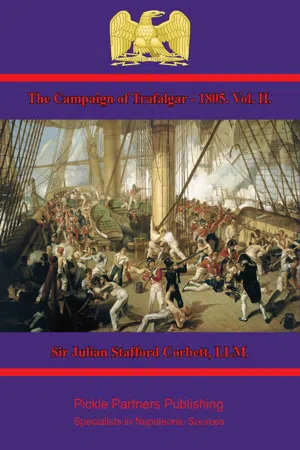
- 295 pages
- English
- ePUB (mobile friendly)
- Available on iOS & Android
The Campaign of Trafalgar — 1805. Vol. II.
About this book
Of the many campaigns in the long history of Britain, naval and otherwise, there have been few more momentous than the campaign in the Mediterranean in 1804-5 culminating in the battle of Trafalgar. They spawned a national hero in the figure of heroic lord Nelson, one-armed and blind in one eye, dying at the moment of his greatest victory over a more numerous enemy. However, the story of the battle, much less the campaign, was more complex than the story of one man, however great. It is this web of sailings, counter-sailings, orders, alliances, courage and genius that Corbett elucidates with his great naval knowledge and lucid text.
Sir Julian Corbett wrote this most important of studies, drawing on not only his comprehensive archive material at the Royal Naval college, but also important sources from French and Spanish sources. He was a prolific author and authority on British warfare, and more particularly the naval aspects, as well as a lecturer in history to the Royal Naval College.
Author — Sir Julian Stafford Corbett, LLM. (1854-1922)
Illustrations – 8 maps and plans.
Frequently asked questions
- Essential is ideal for learners and professionals who enjoy exploring a wide range of subjects. Access the Essential Library with 800,000+ trusted titles and best-sellers across business, personal growth, and the humanities. Includes unlimited reading time and Standard Read Aloud voice.
- Complete: Perfect for advanced learners and researchers needing full, unrestricted access. Unlock 1.4M+ books across hundreds of subjects, including academic and specialized titles. The Complete Plan also includes advanced features like Premium Read Aloud and Research Assistant.
Please note we cannot support devices running on iOS 13 and Android 7 or earlier. Learn more about using the app.
Information
Table of contents
- Title page
- CHARTS AND DIAGRAMS
- CHAPTER XVI
- CHAPTER XVII
- CHAPTER XVIII
- CHAPTER XIX
- CHAPTER XX
- CHAPTER XXI
- CHAPTER XXII
- CHAPTER XXIII
- CHAPTER XXIV
- CHAPTER XXV
- CHAPTER XXVI
- APPENDICES
- APPENDIX B
- APPENDIX C
- APPENDIX D
- APPENDIX E
- APPENDIX F
- APPENDIX G